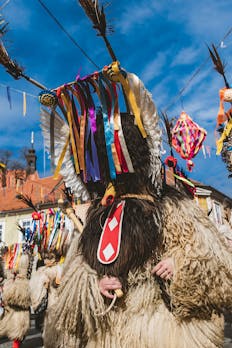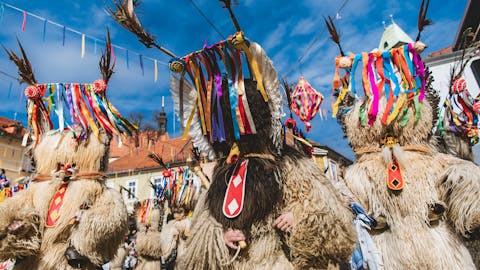
Ptuj Municipality
Kurentovanje Carnival
Tradition
In the history of humankind, masks have occupied an important place due to their widespread use. Thousands of years ago, people tried through disguises to establish contact with the afterlife, demons, gods, and ancestral spirits, as they sought to understand and influence events in nature and in the community. As early as in the old carnival celebrations, which date back to pre-Christian times, people would, through processions of carnival characters and fertility magic, celebrate the arrival of spring and bid farewell to winter. Even Christianity, which opposed such a pagan festival, could not suppress the masquerading.
Carnival survived by being placed before the beginning of the forty-day fasting period before Easter, which in fact lasts 46 days and begins on Ash Wednesday. After merrymaking and excessive consumption of food and drink, which ends on Shrove Tuesday at midnight, the fasting period begins. The word “pust” (carnival) itself announces the fast. It comes from the word “mesopust” – “leave the meat.”
Masks and carnival characters, which developed throughout history, are divided into traditional masks with magical power and more modern carnival masks that respond to various events in the environment with criticism and humor. In Slovenia, the Ptuj and Drava polje the Haloze and the Slovenske gorice region are especially notable for the number and diversity of traditional carnival masks.
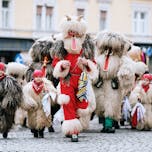
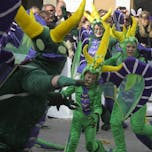
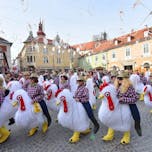
Lonely Planet has ranked Kurentovanje among the ten most interesting carnivals in the world, placing it in the fine company of great carnival cities such as Venice, Rio de Janeiro, and New Orleans. It is an excellent opportunity not only to watch the kurent processions, but also to see numerous ethnographic and carnival parades, discover other traditional or modern carnival characters, enjoy masked entertainment, and more. During Kurentovanje, as part of Artfest, Etnofest, and Karnevalfest, numerous parades, carnival promenades, presentations of ethnographic characters, concerts, masked balls, exhibitions, and much more take place.
Preserving Heritage
In the past, only adult men were allowed to dress up as kurents. From Candlemas, on February 2, until Ash Wednesday, they would walk in groups through their own and neighboring villages, accompanied by the devil, who would steal a pair of sausages from the household. Their arrival at a house meant good luck for the entire coming year. If a kurent rolled on the ground in the courtyard of a homestead, there would be no luck there that year.
Unesco
In 2017, the international organization UNESCO (United Nations Educational, Scientific and Cultural Organization) inscribed the kurent/korant processions on the Representative List of the Intangible Cultural Heritage of Humanity.
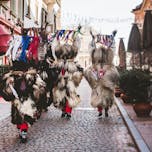
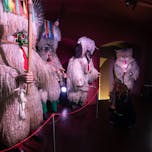

One of the 10 best carnivals in the world, when the town of Ptuj transforms into the largest open-air ethnographic museum of intangible cultural heritage.
Kurentovanje traditionally begins with the Kurent’s Leap, while the main program of the 65th Kurentovanje in 2025 will take place from February 22 to March 4, 2025.
